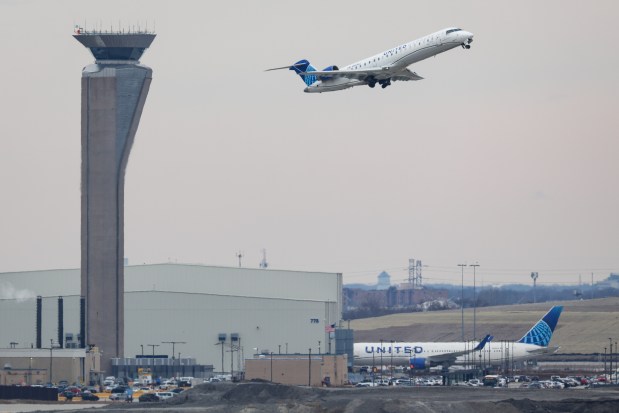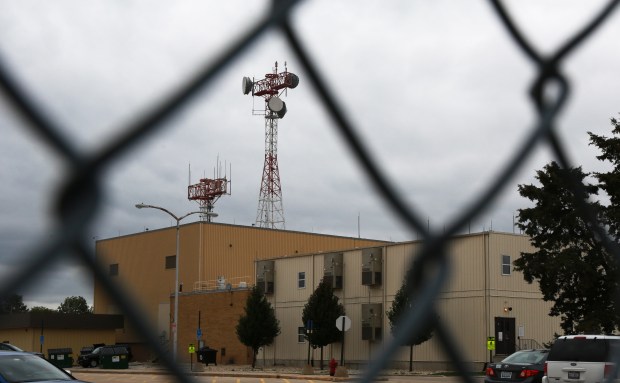The late-January collision between a passenger jet and an Army helicopter brought renewed attention to an issue that has plagued the nation’s air system for years: a shortage of air traffic controllers. And the busy Chicago air corridor has not been immune.
Air traffic control facilities at the city’s two airports, plus two other regional centers, failed to meet a working group’s target staffing levels as of September 2023, according to the most recent published numbers.
For example, in one facility that oversees planes coming to and going from Chicago, the number of fully certified controllers was about 70% of the target staffing levels recommended by the union and Federal Aviation Administration working group. At another regional facility, the number of fully certified controllers was 82% of the group’s recommendation.
Shortages in Chicago were not as acute as those in some other major cities, like New York. Still, they can force air traffic controllers to work overtime and face fatigue in a busy air space that has been recognized as among the nation’s most critical because of the number of airlines and flights served.
“If there’s not enough controllers, people are trying to do too much. And they are probably pretty tired all the time,” said Mark Blaber, a retired Chicago controller who said he now helps train other controllers at the regional facility.
Air traffic controller staffing has long been a concern for federal officials, and again drew heightened attention after the Jan. 29 plane crash. An American Airlines regional jet and an Army helicopter collided as the passenger plane was about to land at D.C.’s Ronald Reagan Washington National Airport, killing all 67 people aboard the two aircraft.
An FAA report called air traffic controller staffing at the time of the crash “not normal,” multiple news outlets reported in the days afterward. One controller was responsible for coordinating helicopter traffic and arriving and departing planes at the time, duties that are often divided between two people. They are typically combined at 9:30 p.m. when traffic begins to slow down, but were combined earlier the night of the crash, according to the Associated Press.
A person familiar with the matter said tower staffing that night was actually normal, and the positions are regularly combined when controllers need to step away for breaks, shift changes or when traffic slows, the AP reported.
The crash, which took place in especially complicated airspace, is still under investigation, and the National Transportation Safety Board is looking into a number of different factors.
Air traffic control staffing had been of particular concern in other cities, too, before the midair collision. In recent years, the FAA allowed major airlines to limit flights into the New York City area without penalties they would normally face for such reductions, as the agency faced a shortage of controllers, according to the Associated Press.
At the same time, near-collisions between planes at some airports also gained attention, like high-profile cases at airports in San Diego and Austin, Texas, in 2023.
In Chicago, four facilities oversee traffic at O’Hare International and Midway airports, and enroute traffic throughout parts of Illinois, Wisconsin, Indiana, Michigan and Iowa. All had fewer fully certified controllers than the working group’s targets in 2023, though all also had additional controllers in various stages of training at that time, according to an FAA Air Traffic Controller Workforce Plan published last year.
The air traffic control tower at O’Hare had 57 fully certified controllers, out of a working group target of 73. Midway had 19 of a recommended 22.
Staffing at two offsite facilities also fell short. The regional center for enroute traffic, based in Aurora and called the Chicago Air Route Traffic Control Center, had 264 fully certified controllers, while the working group set a target of 321. And a facility in Elgin called Chicago TRACON that oversees planes arriving to and departing from Chicago’s airports had 71 fully certified controllers, of a target of 102.
The FAA uses a different measurement of progress toward staffing targets, counting both fully certified controllers and those who were previously certified but have moved to a new role or location and need to be retrained. The agency also sets its own staffing targets that are often lower than the working group’s.
By the agency’s own standards, the towers at O’Hare and Midway and the Elgin facility all met or exceeded FAA staffing targets. The Aurora regional center was still short of the FAA target by a handful of controllers, with dozens more in training.
The FAA said adding to the nation’s air traffic controller workforce was a “top priority.” The agency hired 1,811 controllers in fiscal year 2024, officials said.
“Their work is critical to meeting our safety mission,” FAA officials said in a statement.
The Aurora regional center has routinely relied on overtime in some sectors, Blaber, the retired controller, said. In some areas of the facility, controllers have worked six-day workweeks 40 times a year, he said.
New rules limit the number of consecutive overtime assignments controllers can work and mandate how much time off controllers must have between shifts, in an effort to address controller fatigue. But Blaber worried those rules would cause other scheduling challenges.
Blaber and others said there is little reason for safety concern. As the share of air traffic that is made up of jets grows and planes have more automated safety systems, the complexity of directing air traffic and the risks if something goes wrong have declined, he said.
Former Chicago-based pilot Skip Perillo never noticed any repercussions from a shortage of air traffic controllers. He said he flew for American Airlines for 30 years and for the military before that, though he stopped flying shortly after the COVID-19 pandemic began.
“Chicago, to me — and I might be biased — but they’ve always been excellent,” he said. “The best in the industry as far as I’m concerned.”

Even so, at O’Hare, a database of voluntary safety reports maintained by NASA shows the complexity of navigating the airport for pilots and controllers.
In one recent case, a pilot reported nearly colliding with another plane on the ground one night in October. While taxiing through the congested airport after landing, the pilot had to “abruptly stop the aircraft” to avoid hitting another plane moving quickly nearby, the pilot reported. Neither plane had deviated from air traffic control directions, according to the pilot, who listed five potential causes for the near-collision including “(air traffic control) was very busy and saturated.”
In August, a pilot reported another plane crossing their runway as the crew were preparing to land, so they pulled up and went around for another attempt at landing. The pilot later determined the second plane was crossing at a point farther down the runway, beyond where the landing plane’s crew were told to stop and had planned to turn off, but noted risks of the situation nonetheless. The pilot did not speculate about why the plane was crossing the runway.
“None of us has ever seen another aircraft cross an active runway while a landing aircraft is in the flare or rolling down the runway,” the pilot wrote. “If this is the new traffic pattern procedures at ORD, I think it is trouble waiting to happen.”
Though air traffic control staffing is managed at the federal level, city aviation department officials who oversee O’Hare and Midway in a statement emphasized their focus on safety.
“We remain committed to collaborating with the FAA and investing in modern infrastructure to further enhance safe and efficient operations,” they said.
Still, the air traffic controllers union considers staffing to be a “crisis” nationwide, and Chicago remains part of the trend, said Drew MacQueen, Great Lakes regional vice president for the National Air Traffic Controllers Association. Shortages at the facilities in Aurora and Elgin, though they are not located directly at airports, exacerbate the strain on the system, he said.
“It’s not just one facility by itself, they are all intertwined in the safe expeditious flow of air traffic,” he said. “It matters across the board.”
The application and training process to become a fully certified controller can take three years, he said. Would-be controllers can wash out during the process, especially at busy, complicated facilities like those in Chicago, Blaber said.
Adding to staffing challenges are mandatory retirement ages. And cities with higher costs of living might see more requests to transfer out, though that doesn’t seem to be a problem in the Chicago area, Blaber said.
Ultimately, those that make it through training are highly qualified, MacQueen said.
“There is a staffing shortage, a staffing crisis everywhere,” he said. “Certainly Chicago is indicative of that, certainly the Chicago facilities are emblematic of the same thing that we’re all experiencing”



